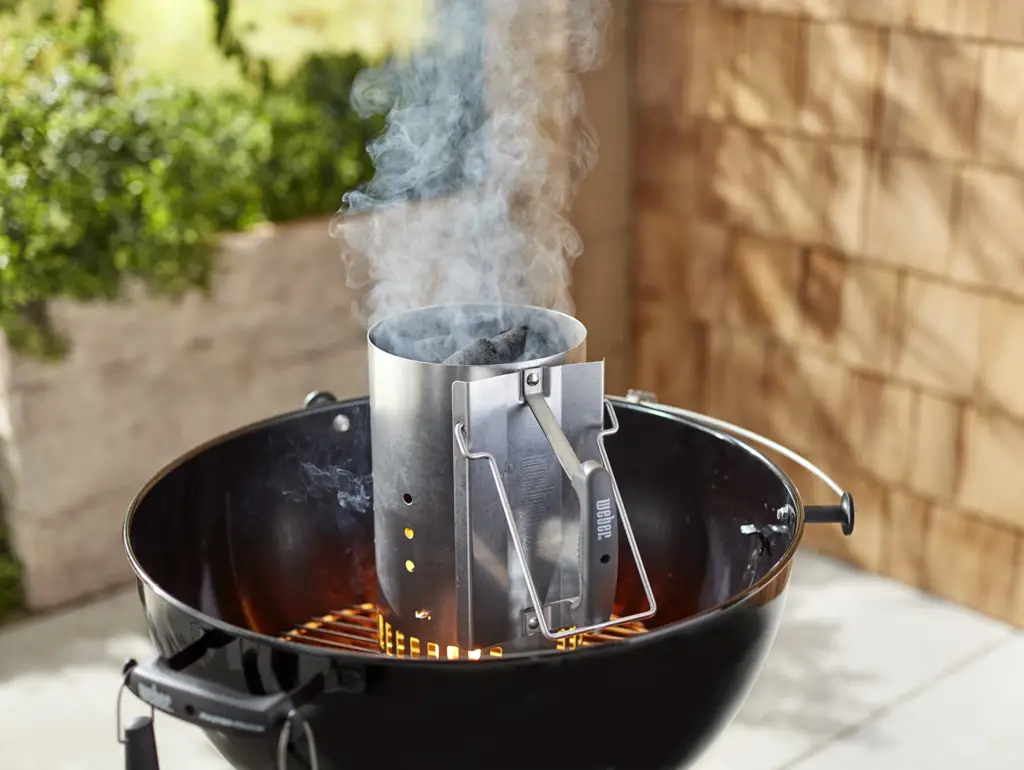Share via:
Whether you’re a seasoned grill master or a novice looking to hone your skills, there are always new tips and tricks to discover that can take your grilling game to the next level. Transform your grill game and elevate your cookouts with these incredible grilling tips!

Achieving grilling perfection requires attention to detail, such as proper preparation of your ingredients, mastery of cooking techniques, and understanding how to maintain and clean your grill effectively. We will delve into a variety of strategies, including how to optimize smaller portions, the best way to cook chicken on the grill, and cleaning hacks using common household items. With these tips and more, you can feel confident in your ability to create mouthwatering meals that will have everyone asking for seconds.
Essentials of Grilling

1- Choosing the Right Grill
There are two main types of grills: charcoal and gas. Charcoal grills provide a smoky flavor and require the use of charcoal as fuel. They can take longer to heat up, but they often have a lower initial cost. Gas grills, on the other hand, use propane or natural gas and heat up faster.
They generally offer a more convenient and cleaner grilling experience but can be more expensive initially. This article provides some helpful tips for choosing the right grill for your needs.
2- Understanding Heat Levels
Managing heat levels is crucial for successful grilling. You’ll generally want to create two zones: a direct heat zone for fast cooking and searing, and an indirect heat zone for slower cooking or to avoid flare-ups from dripping fat.
It’s important to know when to use high heat, medium heat, or low heat for different types of food. For example, use high heat for searing steaks and medium heat for cooking poultry. You’ll also want to learn how to control the heat in your grill, whether by adjusting the vents on a charcoal grill or the knobs on a gas grill.
3- Grilling Tools Must-Haves

Having the right tools can make your grilling experience more enjoyable and efficient. Here are some essential grilling tools:
- Grilling Tongs and Turner Set
- Stainless Steel Grill Basket
- Basting Brush
- BBQ Metal Skewers
- Meat Thermometer
- Fish Turner
- Grill Prep and Serve Trays
- Grill Press
In addition to these basic tools, you can also invest in other grilling accessories like a chimney starter for quickly igniting charcoal or skewers for making kebabs.
Preparation Techniques
4- Selecting the Best Cuts
Choosing the right cut of meat is crucial for achieving optimal grilling results. Select cuts with a good balance of fat and muscle, as this will enhance the flavor and tenderness of the cooked meat.
For example, a ribeye or New York strip steak is ideal for grilling due to its marbling and thickness. For poultry, choose bone-in, skin-on pieces for added flavor and moisture.
Related > > Most tender steak cuts
5- Seasoning and Marinades
To elevate the taste of your grilled dishes, focus on appropriate seasoning and marinades. A simple blend of salt and pepper can go a long way in enhancing the natural flavors of the meat.
For more complex tastes, explore various herbs, spices, and rubs.
Marinades also help in infusing the meat with flavors. An effective marinade typically includes an acidic component, such as lemon juice or vinegar, along with aromatic ingredients like garlic and herbs. Spoon University recommends marinating for at least 30 minutes to a few hours for best results.
6- Preheat Your Grill
Preheating your grill is essential for ensuring an even cooking surface and preventing food from sticking to the grate. This step also helps in achieving those desirable grill marks.
Allow your grill to preheat for at least 10 to 15 minutes before placing the food on it. Gas grills usually reach the desired temperature more quickly than charcoal grills. The Spruce Eats provides valuable tips on optimizing your gas grilling experience.
7- Oil the Grate to Prevent Sticking
Before grilling, make sure to oil the grate to prevent food from sticking and make it easier to flip and remove the meat. Apply a thin layer of cooking oil on a paper towel and use tongs to rub it over the grate. This should be done after preheating the grill but before placing the food on it.
For increased safety, turn off the grill briefly while oiling the grate. As mentioned on Family Handyman, this simple technique can greatly improve your grilling experience and the quality of your cooked food.
Grilling Various Foods
8- Vegetables and Fruits
Grilling vegetables and fruits can bring out their natural flavors and add a delightful smoky touch. To ensure a perfect result, it’s important to know your grill. Here are a few essential techniques to apply when grilling these ingredients:
- Preparation: Wash and pat dry the vegetables and fruits before grilling. Cut them into uniform sizes for even cooking.
- Marinating: Lightly coat the vegetables and fruits with olive oil or your favorite marinade. This helps to prevent sticking and enhances flavor.
- Cooking: Use a medium-high heat (350-450°F) for most vegetables and lower heat (300-350°F) for delicate fruits. Use a grill basket or grilling mat to prevent small pieces from falling through the grates.
9- Grilling Fish

ure and infusing it with delightful flavors. Start by preheating your grill to medium-high heat. Cut thick slices of lemons, limes, or oranges. These will act as a natural barrier between the grill grates and the fish.
Lightly oil the grill grates and lay the citrus slices directly on them. This creates a fragrant and slightly acidic base that prevents the fish from sticking and adds a subtle citrus flavor.
Season your fish fillets with your favorite herbs, spices, salt, and pepper. Place them gently on top of the citrus slices. Close the grill lid to ensure even cooking.
Remember, fish cooks quickly, so keep an eye on it. Depending on the thickness of the fillets, they typically take around 3-5 minutes per side. Use a spatula to carefully flip the fish halfway through cooking.
10- Grilling Pizza and Bread
Grilled pizza and bread are crispy and smoky, making them a fantastic alternative to baking. To achieve that perfect crust and even cooking, follow these grilling techniques:
Pizza
- Preparation: Preheat the grill to medium-high heat (400-450°F). Assemble ingredients for quick and easy topping of dough.
- Grilling: Grill pizza dough on one side for 2-3 minutes, then flip and quickly add toppings. Close the grill lid to melt the cheese and cook the dough.
Bread
- Preparation: Preheat the grill to medium-high heat (400-450°F). Cut bread into slices or smaller pieces for even cooking.
- Grilling: Place bread directly on the grill grates and cook for 1-3 minutes per side. Keep a close eye to prevent burning.
Mastering the Techniques
11- Direct vs Indirect Grilling
Grilling techniques play a vital role in enhancing the overall taste and appearance of your grilled food. One primary distinction is between direct and indirect grilling.
Direct grilling refers to placing food items directly over the heat source, allowing for quick cooking of thinner cuts like burgers and steaks. Indirect grilling, on the other hand, involves placing food off to the side of the heat source, making it ideal for thicker cuts and longer cook times. Familiarize yourself with both methods to achieve better grilling results.
12- Controlling Flare-Ups
Flare-ups are a common yet troublesome aspect of grilling. To prevent them, trim excess fat from meat beforehand and keep a spray bottle of water nearby to douse sudden flames. Maintaining a clean grill also helps in reducing flare-ups, as grease buildup can catch fire.
13- Using a Thermometer
A crucial aspect of grilling is achieving the perfect temperature. Rely on an instant-read digital thermometer for accurate measurements, ensuring your meat is cooked to perfection and food safety standards. Remember that different types of meat require different internal temperatures.
Internal Temperature Guidelines (follow USDA recommendations):
| Meat | Temperature (°F) |
|---|---|
| Beef, Pork, Lamb | 145 |
| Ground Meats | 160 |
| Poultry | 165 |
Note that the meat’s temperature will continue to rise a few degrees after removing it from the grill.
14- Turn your grill into a smoker
Transforming your grill into a smoker is a fantastic grilling hack that can infuse your dishes with incredible smoky flavors.

To turn your grill into a smoker, start by soaking wood chips in water for about 30 minutes to an hour. Wrap the damp chips in aluminum foil, poking some holes on the top to allow smoke to escape.
Once your grill is preheated, place the foil packet directly on the heat source or on the grate. Adjust the grill temperature to a lower setting and place your food on the cooler side, allowing the smoke to permeate it slowly as it cooks. Monitor the temperature closely to maintain the ideal smoking conditions for your dish.
15- Keep burgers moist with butter or an ice cube

A clever trick to ensure juicy burgers is to add a small ice cube or a pat of butter to the center of the patty before grilling. As the burger cooks, the ice cube melts or the butter melts and keeps the meat moist from the inside out.
This extra touch of moisture adds flavor and prevents the burgers from drying out, especially if you’re cooking leaner cuts of meat. Just press the ice cube or butter into the center of the patty, grill as usual, and enjoy a perfectly moist burger.
16- Don’t flip the Food On the Grill Too Often.
Limiting how often you flip your food on the grill can make a difference in its overall taste and texture.
For most items, flipping once is generally sufficient. It allows for even cooking, creates those appealing grill marks, and ensures that the food doesn’t lose its juiciness by being moved around excessively. Practice patience and let the grill work its magic on one side before giving it that perfect flip.
Resist the urge to flip your meat too often. Flipping once or twice is usually enough to ensure even cooking. If you try to lift the meat before it is ready it will stick to the grates. Let the meat develop a crust before you try to move it.
17- Keep the lid closed
Keeping the grill lid closed while cooking is like maintaining an oven environment, allowing heat to circulate evenly around the food. It helps in trapping the heat, ensuring consistent cooking and enhancing the smoky flavor.
The lid also prevents flare-ups by controlling airflow and keeps the temperature steady. While it’s tempting to frequently check on the food, especially when grilling, keeping the lid closed as much as possible leads to better, more predictable results.
18- Resting the Meat
An often-overlooked aspect of grilling perfection is resting the meat after cooking. It allows juices to redistribute within the meat, yielding a juicier and more tender bite.
Rest the meat for at least 5 minutes (up to 15 minutes for larger cuts) before serving or slicing, and you’ll notice a considerable difference in taste and texture.
Safety and Maintenance
19- Regular Cleaning
Regular cleaning is essential for maintaining a safe and efficient grill. Over time, grease and food particles can build up on the grates and inside the grill. This buildup increases the risk of flare-ups and can affect the taste of your food. To keep your grill clean, follow these simple steps:
- Preheat the grill: Turn on the grill for 10-15 minutes to burn off any excess residue.
- Scrape the grates: Use a long-handled grill brush to thoroughly scrape and clean the grates. You might consider using a grill brush specifically designed for your type of grill.
- Clean the interior: After the grill has cooled down, remove any leftover food debris and grease from the bottom and walls of the grill.
- Inspect the burners: Make sure the burners are free of debris and in good working order.
20- Checking for Gas Leaks
Gas leaks are a serious safety hazard, so it’s essential to regularly check your grill for any leaks. Follow these steps to ensure your grill’s gas connections are secure and leak-free:
- Tighten connections: Make sure the connections between the gas tank, hose, and grill are secure.
- Perform a leak test: Mix a solution of soapy water and apply it to the length of the hose and connections. Turn on the gas and look for any bubbles indicating a leak. If you find a leak, replace the hose or tighten the connection.
21- Checking your propane level with warm water

Checking your propane tank’s gas level is essential for uninterrupted grilling. An easy way to do this is by pouring warm water down the side of the tank and then feeling it with your hand. The level where the tank feels cool to the touch indicates the amount of propane inside.
This trick helps estimate how much gas is left in the tank without relying solely on a gauge, ensuring you’re ready for your next barbecue without any surprises.
Related > > How much does an empty propane tank weigh
22- Proper Food Handling
Proper food handling is crucial for preventing foodborne illnesses and ensuring a safe and enjoyable grilling experience. Use these basic food handling tips for a safe cookout:
- Prevent cross-contamination: Use separate utensils and plates for raw and cooked meats to avoid transferring bacteria.
- Marinate safely: Marinate meats in the refrigerator rather than at room temperature, and do not reuse leftover marinade.
- Cook to proper temperatures: Use a meat thermometer to ensure that meats are cooked to the recommended internal temperatures to kill any harmful bacteria.
- Keep perishable foods cold: Store perishable ingredients in a cooler with ice to maintain safe temperatures until ready to use.
Advanced Grilling Tips
23- Creating Smoke Flavors
One of the best ways to add depth to your grilled dishes is by infusing smoke flavors into your food. You can achieve this by using different types of wood chips or pellets.
Each wood type imparts a unique flavor profile to your food. For example, applewood gives a mild and sweet flavor, while mesquite imparts a strong and earthy taste. Experiment with the following wood types to find your favorite:
- Applewood: Mild and sweet
- Hickory: Strong and savory
- Cherry: Delicate and fruity
- Mesquite: Robust and earthy
Tip: Soak wood chips in water for about 30 minutes before placing them on your grill to help create more smoke.
24- Grill Marks and Presentation

The art of grilling is not only about the taste but also the visual appeal. Perfectly seared grill marks add a professional touch to your dishes. To achieve those crosshatched lines:
- Preheat: Ensure your grill is hot before placing the food on it.
- Position: Place your food at a 45-degree angle to create diagonal grill marks.
- Rotate: After a few minutes, rotate your food 90 degrees to create the second set of diagonal lines.
- Flip: Turn your food over and repeat the process on the other side.
Related > > How to get grill marks without grill
25- Experimenting with Glazes and Sauces
Elevate your grilling experience by experimenting with glazes and sauces. Glazes provide a glossy finish and an extra layer of flavor, while sauces can be served on the side, allowing your guests to customize their plates. Here are some ideas to get you started:
- Honey-glazed: Combine equal parts honey, soy sauce, and fresh lime juice for a sweet, tangy flavor.
- Barbecue: Mix ketchup, brown sugar, vinegar, mustard, and a little Worcestershire sauce for a classic BBQ sauce.
- Teriyaki: Combine soy sauce, brown sugar, garlic, ginger, and cornstarch to create a thick teriyaki glaze.
- Chimichurri: Blend parsley, cilantro, garlic, olive oil, and vinegar for a fresh and zesty sauce.
Feel free to adjust the ingredients and quantities to suit your personal preference. These versatile glazes and sauces can easily transform any meal into a mouthwatering treat!
Troubleshooting Common Issues
26- Uneven Heating
It’s not uncommon for grilling enthusiasts to encounter issues with uneven heating on their grill. To address this issue, ensure that your grill grates are clean and free of any debris that could obstruct heat distribution.
If the problem persists, check the burner for any blockages and adjust the air shutter as needed to regulate the oxygen flow to burner 1. It’s also important to know your grill well and understand its hot spots. You can do this by placing slices of bread on the grill and observing browning patterns 2.
27- Food Sticking
Grill users often face the challenge of food sticking to the grill grates. To resolve this, always preheat your grill, which will help to caramelize the food and prevent sticking. Another solution is to clean the grill grates thoroughly before and after each use 3.
Oiling both the grate and the food item can significantly reduce sticking4. For delicate or small items like fish and vegetables, consider using grill baskets or non-stick grilling mats.
28- Flavor Imbalances
A great grilling experience is all about striking the right balance between smokiness, tenderness, and seasoning. To avoid flavor imbalances, follow these tips:
- Marinate or season your food in advance to ensure even flavor distribution5
- Balance smoky flavors by using a combination of indirect and direct heat cooking methods
- Monitor your grill’s temperature, as excessive heat may cause bitter flavors6
Remember, practice makes perfect, so don’t be afraid to invest some time honing your grilling techniques to achieve those near-perfect flavors and well-cooked meals.
Serving and Presentation
29- Keeping Food Warm
To ensure your grilled food stays warm and delicious until everything is ready to serve, make use of your grill’s heating rack. This area is perfect for keeping cooked foods warm without overcooking them.
Another option is to use a preheated oven at a low temperature (around 200°F). Place cooked items on a baking sheet, cover with aluminum foil, and keep them in the oven until you’re ready to serve.
30- Slicing Techniques
Proper slicing techniques can improve the taste and texture of your grilled meats. For the best results, always slice against the grain. This means cutting perpendicular to the muscle fibers, which makes the meat more tender and easier to chew. Some examples of proper slicing techniques include:
- Steak: Cut into thin strips at a 45-degree angle.
- Chicken Breast: Cut diagonally into 1/2-inch thick slices.
- Pork Tenderloin: Slice into 1/4-inch thick medallions.
31- Plating and Garnish
Presentation is key when serving grilled dishes, as it enhances the overall dining experience. Here are some tips for plating and garnishing:
- Color and Contrast: Use different colored foods and sauces to create contrast on the plate. For example, pair grilled chicken with vibrant vegetables or a colorful sauce.
- Portioning: Arrange protein, starch, and vegetables in a balanced manner for a visually appealing meal.
- Garnishing: Add a touch of freshness and elegance to your dishes with fresh herbs like parsley, basil, or cilantro. Edible flowers can also be used for an extra touch of sophistication.
Remember, a well-presented dish not only looks inviting but can also make the food taste better. So while grilling your masterpieces, don’t forget these essential serving and presentation tips.
I am a writer, editor, and publisher of Grillcuisines.com – an online blog dedicated to sharing grilling tips, accessories, and recipes to encourage more people to get outside and grill.
I’m off to find out the different types of grill foods, their seasons, and how to conduct outdoor cooking properly. I’ll also show you some of my grill-worthy cooking tools & accessories!


